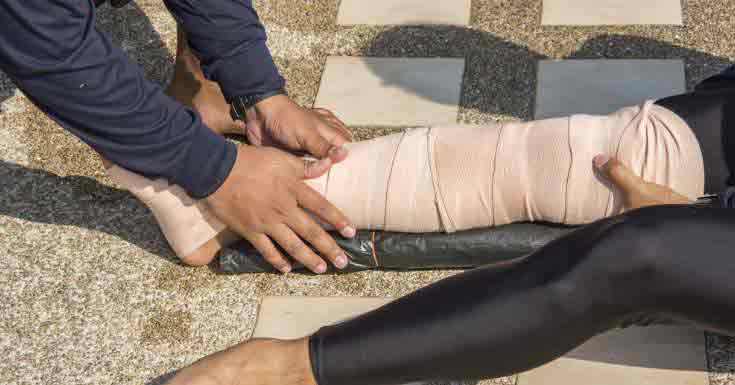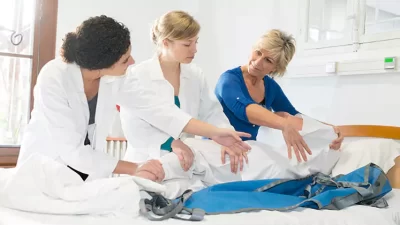Joint pain is a symptom we are all familiar with, whether it is caused by an acute or chronic condition. Sore joints can also be caused by physical activities, including weight lifting, contact sports, and even swimming.
It is important that the actual cause of the joint pain is correctly identified; once you have obtained an adequate diagnosis, you can pursue the best course of treatment.
Certain conditions can cause the joint pain to progress, so you should not delay the start of the treatment. The sooner you will start the treatment, the better your outcome is going to be.
What are the Main Causes of Sore Joints?
Osteoarthritis
This is an inflammatory condition, caused by age-related degeneration of the cartilage and soft tissues. It is common for osteoarthritis to affect the joints of the knees and hips, as well as of the spine and hands.
The chronic inflammation leads to sore joints, with the range of motion being reduced. This is a progressive condition, which can impact the functioning of the affected joints.
Rheumatoid Arthritis
Rheumatoid Arthritis is an autoimmune disorder, characterized by chronic inflammation and a progressive loss of function in the affected joints.
The lining of the joints is primarily affected, leading to pain and inflammation among other symptoms. The condition can progress to severe stages, with the joints becoming deformed and extensive erosion of the bone.

Psoriatic Arthritis
Psoriatic Arthritis as the name clearly states it; this form of arthritis is encountered in those who suffer from psoriasis. It is common that the joint pain appears after the psoriasis manifestations but the inverse situation has also been encountered.
The condition can range from moderate to severe, involving one or several joints. Periods of remission are possible, with the patient experiencing a calming of the symptoms.
Septic Arthritis
Septic arthritis is a serious condition, being caused by a bacterial, fungal or viral infection. The microorganisms can travel through the bloodstream and reach the joints, causing sepsis.
This condition is present in both children and adults; left untreated, it can progress to life-threatening symptoms. Bone and cartilage damage can also occur, especially in the knee joints.
Reactive Arthritis
This particular form of arthritis is caused by an infection in another part of the body, such as the urinary tract, genital area or intestinal tract.
The inflammatory process appears at the level of major joints, as a form of response to the existent infection (hence the name reactive arthritis). The condition tends to resolve itself, as the infection is cleared out of the body.
Bursitis

The inflammation of the bursa, the small sack of fluid that cushions the joints, is also known as bursitis. This condition can lead to joint pain, preventing the affected joint from functioning properly.
This inflammation is commonly seen at the level of the hip, elbow and shoulder joints; it can also be seen in the knee joints, heels and toes.
Tendinitis
Tendinitis is an inflammatory condition, which is common in those who play sports (tennis, golf etc.). The tendons of the joints are affected by the inflammatory process, with pain and motion restriction appearing as subsequent changes.
The condition is also seen in baseball pitchers, swimmers, and professional jumpers. Left untreated, it can progress to tendon rupture.
Joint Dislocation
The joint dislocation is commonly caused by physical injuries to the respective joints, with the final part of the bones being forced out of its normal position.
The condition is extremely painful, with impossibility of movement being a consequence. Dislocation requires immediate medical attention, in order for the bones to be returned to their normal positioning.
Other Conditions

- Gout – Accumulation of excess uric acid in different joints, preventing the patient from walking or bearing weight on the affected foot.
- Ankylosing Spondylitis – Inflammatory condition which commonly affects the joints of the spine (fusion and posture change)
- Bone Cancer – Malignant changes at the level of one or several bones, more common in children than in adults
Note: Joint pain can appear as an allergic reaction to medication, as a result of intense physical training or due to injuries, such as sprains and strains. It can affect both children and adults, with the symptomatology being however different.
Symptoms
These are the most common symptoms that accompany joint pain:
- Inflammation – An inflammatory process occurs at the level of one or several joints, causing a cascade of symptoms to unravel
- Reduced Range Of Motion – When inflammation and pain are present, the respective joint is prevented from fully functioning (hence the reduced range of motion)
- Joint Immobilization – This happens in case of dislocations and/or fractures, requiring immediate medical intervention
- Pulsating Sensation – This is common in case of infection (septic arthritis) or if the patient has a gout attack (excess accumulation of uric acid in the affected joints)
- Redness And Warmth – These two changes are again characteristic of infection, gout or pseudogout
- Fatigue – A common symptom in those who suffer from rheumatoid arthritis (may precede other more obvious symptoms)
- Stiffness – Morning stiffness is present in those who suffer from inflammatory arthritis; prolonged sitting can lead to such symptoms as well
- Fever – This is a sign of generalized infection, as it can happen in those who suffer from septic arthritis
- Numbness And Tingling – These symptoms are common in case of tendinitis; if the inflammation is severe, it is highly likely it will cause pressure on the nerves (hence these abnormal sensations)
- State Of General Malaise – characteristic for all forms of arthritis, bone cancer, injuries etc.
- Weight Loss – This is a common occurrence in case of bone cancer, being accompanied by appetite loss; the more pronounced the weight loss is, the more aggressive the bone cancer.
- Inflammation In Other Parts Of The Body – This is common for patients who suffer from connective tissue disease, such as lupus.


Treatments
There are a number of treatments that can be pursued when it comes to joint pain, in accordance with the underlying condition.
Oral medication
- Anti-inflammatory non-steroidal drugs (NSAIDs)
- Assist in joint inflammation relief
- Should be administered with caution in those who suffer from kidney or liver disease
Analgesics
- Recommended for more severe joint pain and inflammation
- Cannot be taken for prolonged periods of time, due to the risk of addiction
- May cause unwanted side-effects/adverse reactions
Antirheumatic Medication
- Recommended for different forms of arthritis
- Methotrexate is commonly administered
- May cause unwanted side-effects/adverse reactions, requiring a change in treatment
- Topical Medication
Anti-inflammatory/analgesic creams/ointments
- Superficial effect, cannot penetrate into the deeper layers of the skin
- Can improve the symptoms experienced (also placebo effect)
Corticosteroid Injections

- Recommended in case of severe pain and inflammation
- Administered directly at the level of the affected joints
- Cannot be taken for a prolonged period of time, due to the high-risk of side-effects
- Surgical Interventions
Debridement of loose cartilage fragments in the affected joints
Removal of excess fluid from a joint (using arthroscopy as a method)
Reparation of joint deformity/injuries/fractures
Physical Therapy
Recommended for any kind of joint pain, regardless of the underlying condition
The physical therapist can recommend a program of exercises that will bring joint pain relief
One can also be taught which movements to avoid and how to stop the inflammation from becoming worse
Hydrotherapy
An excellent form of therapy for those who suffer from arthritis
Movements are easier performed underwater
Water has an amazing effect on joint pain and inflammation, helping the patient feel better overall
Occupational Therapy
The occupational therapist can teach the patient how to use the affected joint to its full potential
Adaptation of the home environment to the current status
Working on daily living activities and increasing the current level of independence
Kinesiology Taping
Application of kinesiology tape at the level of the affected joints
Can bring down the pain and inflammation, improving the overall range of motion in the said joint
Treatment can be performed for a long period of time, as there are no side-effects or adverse reactions to worry about
Casting
Necessary for those who have suffered from bone fractures or joint dislocation
Physical therapy might be recommended in the post-operative period.

Final Word
If you are suffering from joint pain and other associated symptoms, you should not delay going to the doctor. Based on the clinical examination and imaging investigations, the medical specialist will recommend a course of treatment to be followed.
As you have seen, joint pain can be caused by chronic conditions; many of these do not have a cure but they can be well kept under control with the help of medication and different interventions.
The most important thing is that you visit the doctor, in order to assess the progression of your condition; sometimes, you might benefit from a new form of treatment or therapy.
Feature Image: Shutterstock.com
In-Post Image: Shutterstock.com







 This article changed my life!
This article changed my life! This article was informative.
This article was informative. I have a medical question.
I have a medical question.
 This article contains incorrect information.
This article contains incorrect information. This article doesn’t have the information I’m looking for.
This article doesn’t have the information I’m looking for.